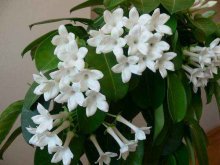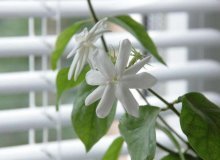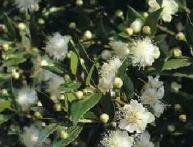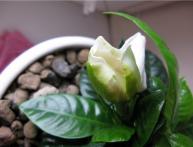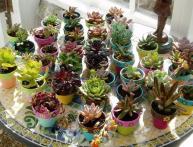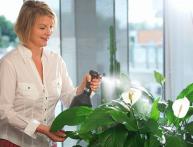Indoor jasmine: planting, growing conditions, basic care
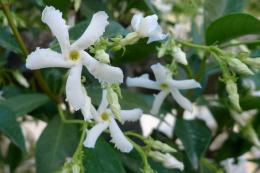
Jasmine is a perennial, evergreen plant. This is a very beautiful flower with a pleasant rich aroma. Two are grown at home varieties: Sambac and Holotsvetkovy. Thanks to long flowering and easy care, these varieties have won the hearts of many indoor flower lovers.
Content:
Planting jasmine
The first flower transplant is carried out after purchasing the plant. The flower is first kept in room conditions for 10-14 days. During this time, the plant will acclimatize and replanting will not be too stressful for it. Jasmine up to 4 years of age is replanted every year. The frequency of replanting for an older flower is once every 2-3 years.
Basics of proper planting of jasmine
A more favorable period for replanting jasmine is the beginning of spring. Usually the flower is replanted in the first ten days of March. Selection of a flower pot. Since indoor jasmine is a plant of medium growth intensity, pots of medium depth are suitable for its cultivation. The diameter of the pot is selected depending on the previous size.

With each transplant, it increases by 3 cm. Material for making the flowerpot: clay, plastic, glass. Metal containers cannot be used. A prerequisite is the presence of holes for drainage. Priming. For indoor jasmine, light, loose soil with good aeration and moisture permeability is suitable.
You can prepare the soil mixture yourself or purchase it ready-made at a garden store. The composition should be selected according to the age of the plant. For young jasmine, sand, clay-turf and leaf soil are mixed in a ratio of 1:1:1. The proportion for an adult is 1:2:1. Jasmine does not like alkaline and neutral soils. The soil acidity indicator is within the pH range of 6-6.5.
Planting depth. The root collar of the plant should be deepened into the ground no more than 2-3 cm. If the plant is located deeper, the jasmine may not bloom. Planting or replanting is one of the important points when growing indoor jasmine. The further development of the plant and its external attractiveness depend on it.
Conditions for growing indoor jasmine
Indoor jasmine is an unpretentious plant and its cultivation does not require much effort. If all the necessary conditions are initially created for the flower, then jasmine not only grows greenery well, but also blooms every year.
Lighting and temperature
Jasmine is a light-loving crop, but does not like direct sunlight. The best place for it would be windows on the east or west side. If the flowerpot is on the south side, direct sunlight is diffused using transparent fabric. The north side is absolutely not suitable. In such a place, jasmine grows slowly and will not bloom.
In summer, a flowerpot with a flower can be placed on a balcony or loggia, but the flower cannot be placed in the sun. If you suddenly change the location to a lighter one, burns may appear on the leaves. Therefore, the light level must be changed gradually.
In the winter season, the temperature is maintained within 13-17 degrees. At higher levels, spraying should be carried out more often and the room should be ventilated regularly. In the spring-autumn period, the recommended temperature is 18-23 degrees. In summer it is necessary to ensure that the temperature does not exceed 24 degrees. If the indicators are higher, the flowerpot is placed outdoors and sprayed with water daily.
Watering
Indoor Jasmine is a moisture-loving plant. This flower does not tolerate overdrying of the earthen coma, but excessive moisture is also unacceptable. When water stagnates, the roots of the flower quickly rot. In summer, abundant watering 3-4 times a week is recommended.
In spring and autumn, three waterings per week are sufficient. In winter, during the flowering period, jasmine is watered every 4-5 days. During the rest of the winter season, water the flower when the top layer of soil becomes dry. For irrigation, use settled or rainwater at room temperature.
Video about indoor jasmine and its care:
Conditions for growing indoor jasmine can be created in almost any room. Therefore, this flower can be grown not only in residential apartments and houses, but also used as decoration in offices and common areas.
Cultivation and care activities
Care It is not difficult to grow indoor jasmine, so even a novice gardener can grow a beautiful and flowering plant. Caring for indoor jasmine is divided into two periods:
- Care immediately after landing
- Care during cultivation
After planting or transplanting, the flower does not require special care. During this period, it is necessary to monitor soil moisture and regularly spray the leaves with clean water. Fertilizers are applied no earlier than after 2 months.Care for growing an adult plant consists of:
- Regular feeding
- Mulching
- Trimming and shaping
Jasmine should be fed from the beginning of spring to the beginning of autumn. Fertilizers are applied every two weeks. With this feeding, organic and mineral mixtures are alternately used. In autumn, the frequency of feeding is once a month. During this period, complex fertilizers are used. In winter, jasmine is not fed.
Mulching the top layer of soil in a flowerpot allows you to slow down the evaporation of moisture and prevent the soil ball from drying out. Mulching can also significantly reduce the amount of watering. Wood shavings, decorative shells and stones are used as mulch.

Trimming jasmine stimulates the growth of new branches, which makes the above-ground part of the flower thicker. It is held annually, in the last ten days of February or the first ten days of March. Weak stems are shortened by half, strong stems are cut by a third. Short young branches are selectively pinched. Jasmine is formed in the shape of a vine entwining the support.
As a support, use ready-made metal or plastic semicircles or make them yourself. The stems are secured with twine. The main rule for caring for indoor jasmine is timeliness.
With insufficient care, the plant loses its visual appeal, weakens and can be affected by pests. Indoor jasmine is an unpretentious plant and does not require special growing conditions. With its help you can not only decorate the room, but also fill it with a unique fresh aroma.

